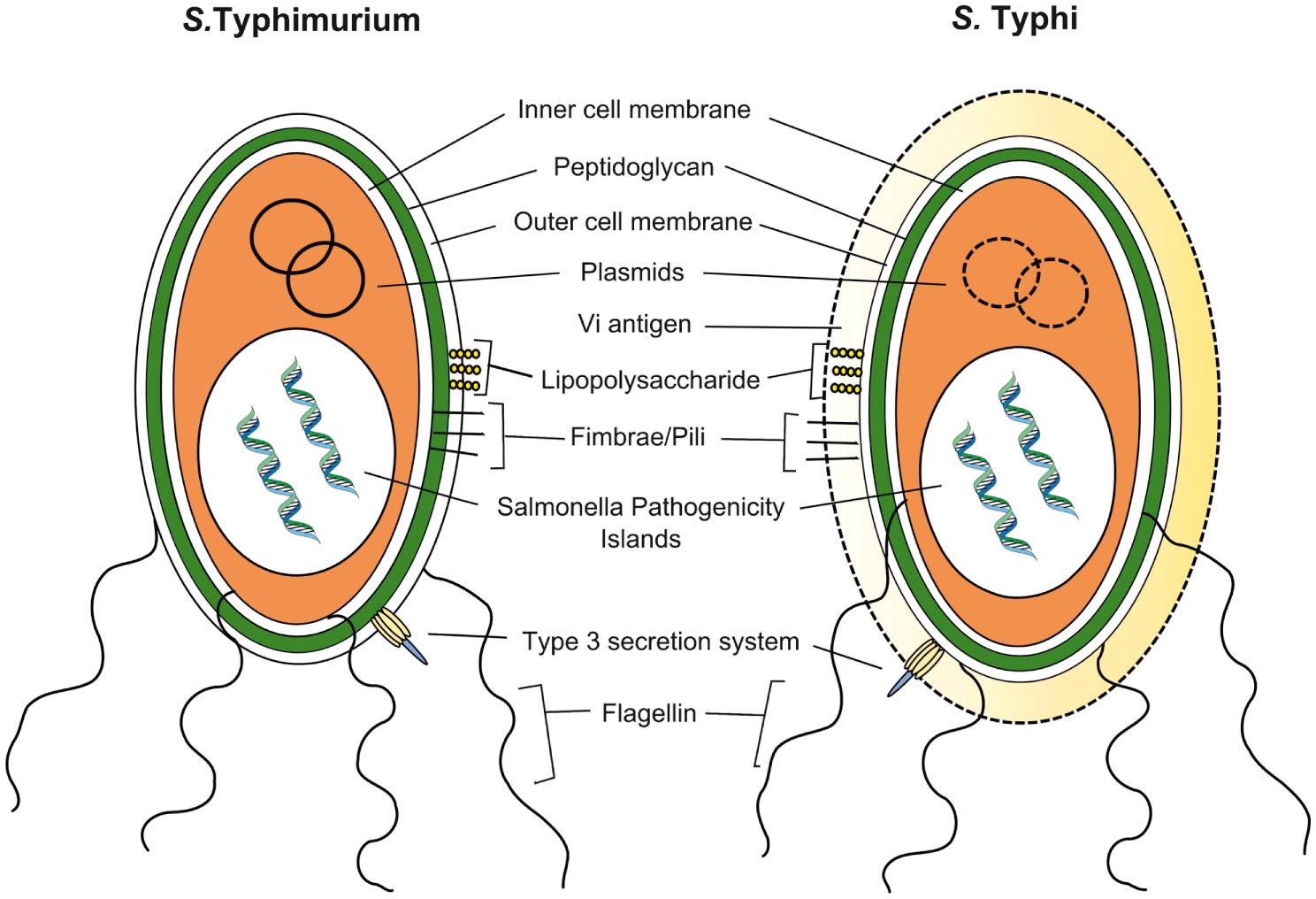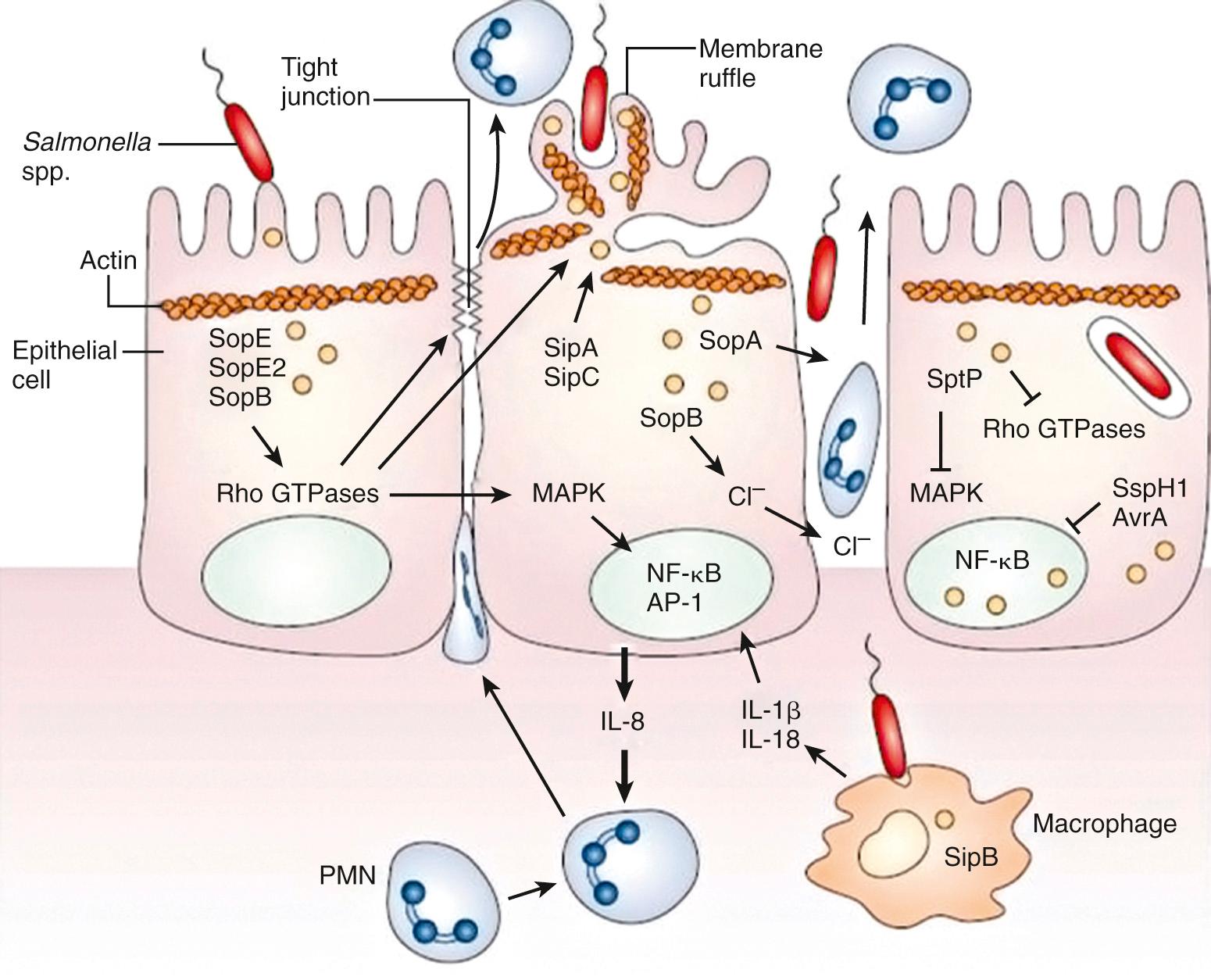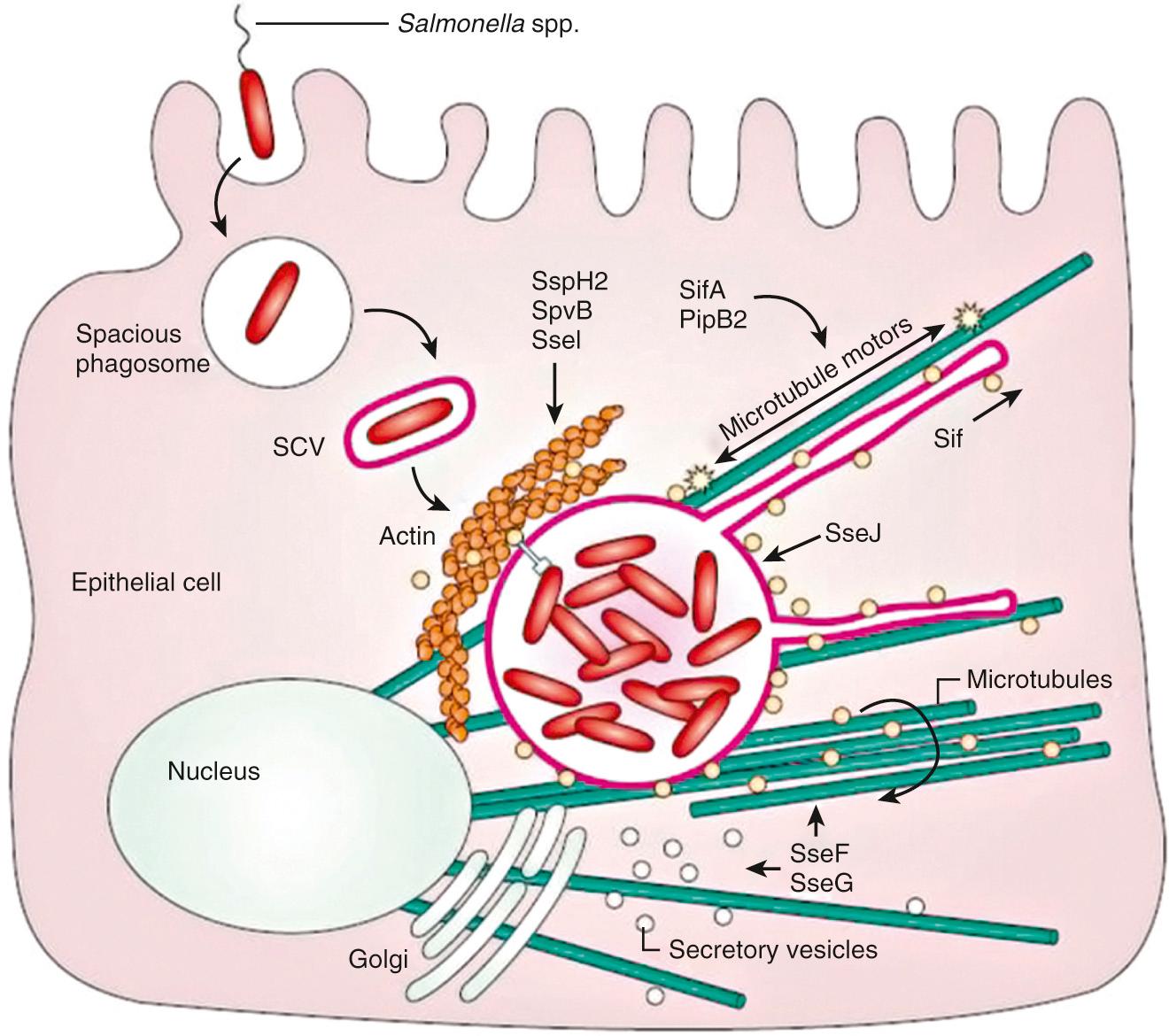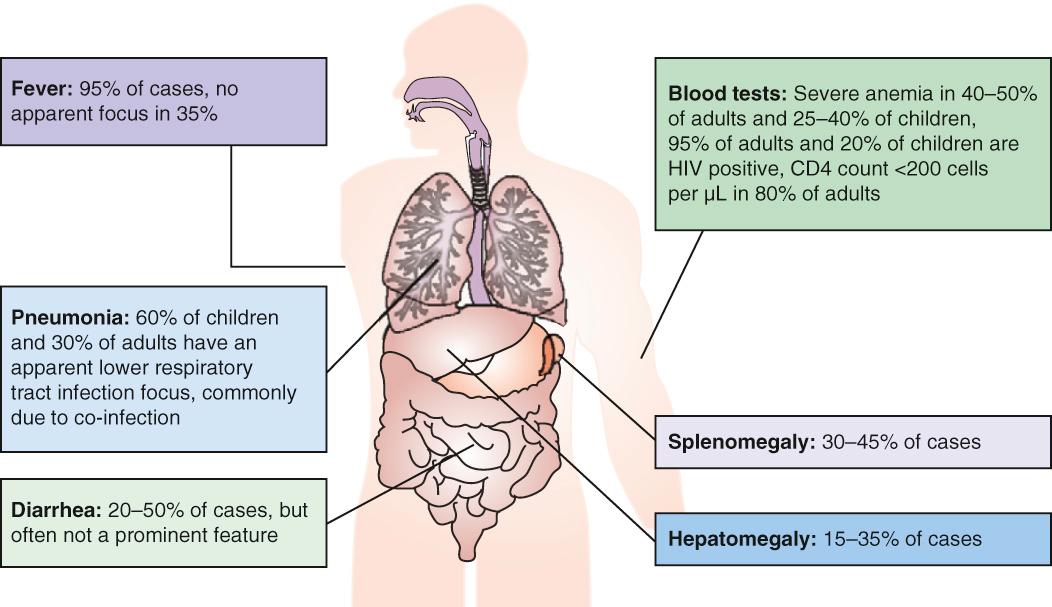Physical Address
304 North Cardinal St.
Dorchester Center, MA 02124
Salmonellosis is a common and widely distributed food-borne disease that is a global major public health problem affecting millions of individuals and resulting in significant mortality. Salmonellae live in the intestinal tracts of warm- and cold-blooded animals. Some species are ubiquitous, whereas others are specifically adapted to a particular host.
The sequencing of the Salmonella enterica serovar Typhi (previously called Salmonella typhi ) and Salmonella typhimurium genomes indicates an almost 95% genetic homology between the organisms. However, the clinical diseases caused by the 2 organisms differ considerably. Orally ingested salmonellae survive at the low pH of the stomach and evade the multiple defenses of the small intestine so as to gain access to the epithelium. Salmonellae preferentially enter M cells, which transport them to the lymphoid cells (T and B) in the underlying Peyer patches. Once across the epithelium, Salmonella serotypes that are associated with systemic illness enter intestinal macrophages and disseminate throughout the reticuloendothelial system (RES). By contrast, most nontyphoidal Salmonella (NTS) serovars induce an early local inflammatory response, which results in the infiltration of polymorphonuclear leukocytes (PMNs) into the intestinal lumen and diarrhea. These NTS serovars cause a gastroenteritis of rapid onset and brief duration, in contrast to typhoid fever , which has a considerably longer incubation period and duration of illness and in which systemic illness predominates and only a small proportion of children have diarrhea.
These differences in the manifestations of infection by the 2 groups of pathogens, one predominantly causing intestinal inflammation and the other leading to systemic disease, may be related to specific genetic pathogenicity islands in the organisms. Most NTS serovars seem unable to overcome defense mechanisms that limit bacterial dissemination from the intestine to systemic circulation in immunocompetent individuals and produce a self-limiting gastroenteritis . In contrast, S. typhi and S. paratyphi (i.e., typhoidal strains of Salmonella ) may possess unique virulence traits that allow them to overcome mucosal barrier functions in immunocompetent hosts, and cause severe systemic illness. Interestingly, the frequencies of typhoid fever in immunocompetent and immunocompromised individuals do not differ. Intriguingly, some invasive NTS strains have been noted in Africa, particularly among HIV-positive adults and among children with HIV, malaria, or malnutrition (see Chapter 225.1 ). The presentation may resemble typhoid fever more than gastroenteritis.
From a taxonomic, Linnaean, perspective, the genus Salmonella belongs to the family Enterobacteriaceae. Two Salmonella spp. exist: Salmonella enterica and Salmonella bongori . The medically relevant species is Salmonella enterica , which is further divided into serotypes and often named based on presumed syndromes they cause or where they were discovered geographically.
From a medical perspective, among the salmonellae causing human disease, serotypes are also clinically grouped as either being typhoidal or nontyphoidal . There are only a few typhoidal Salmonella serotypes, including Salmonella enterica var. Typhi, also known as S. Typhi, and Salmonella enterica var. Paratyphi A. By contrast, there are 1000s of nontyphoidal Salmonella serotypes, collectively called NTS serotypes . NTS serotypes have a broad host range, whereas S. Typhi and S. Paratyphi A are restricted to human hosts.
Salmonellae are motile, nonsporulating, nonencapsulated, gram-negative rods that grow aerobically and are capable of facultative anaerobic growth. They are resistant to many physical agents but can be killed by heating to 54.4°C (130°F) for 1 hr or 60°C (140°F) for 15 min. They remain viable at ambient or reduced temperatures for days and may survive for weeks in sewage, dried foodstuffs, pharmaceutical agents, and fecal material. As with other members of the family Enterobacteriaceae, Salmonella possesses somatic O antigens and flagellar H antigens.
With the exception of a few serotypes that affect only one or a few animal species, such as Salmonella dublin in cattle and S. choleraesuis in pigs, most serotypes have a broad host spectrum. Typically, such strains cause gastroenteritis that is often uncomplicated and does not need treatment but can be severe in the young, the elderly, and patients with weakened immunity. The causes are typically Salmonella Enteritidis ( Salmonella enterica var. Enteritidis) and Salmonella Typhimurium ( S. enterica var. Typhimurium), the 2 most important serotypes for salmonellosis transmitted from animals to humans. Nontyphoidal salmonellae have emerged as a major cause of bacteremia in Africa, especially among populations with a high incidence of HIV infection.
Salmonellosis constitutes a major public health burden and represents a significant cost to society in many countries. Typhoid fever caused by this organism is a global problem, with >27 million cases worldwide each year, culminating in an estimated 217,000 deaths. Although there is little information on the epidemiology and the burden of Salmonella gastroenteritis in developing countries, Salmonella infections are recognized as major causes of childhood diarrheal illness. With the burden of HIV infections and malnutrition in Africa, NTS bacteremic infections have emerged as a major cause of morbidity and mortality among children and adults.
NTS infections have a worldwide distribution, with an incidence proportional to the standards of hygiene, sanitation, availability of safe water, and food preparation practices. In the developed world, the incidence of Salmonella infections and outbreaks has increased several-fold over the past few decades, which may be related to modern practices of mass food production that increase the potential for epidemics. Infections with NTS serovars such as S. Typhimurium and S. Enteritidis cause a significant disease burden, with an estimated 93.8 million cases worldwide and 155,000 deaths each year. Traditionally, Salmonella gastroenteritis accounts for more than half of all episodes of bacterial diarrhea in the United States, with incidence peaks at the extremes of ages, among young infants and elderly persons. Most human infections have been caused by S. Enteritidis; with S. Typhimurium incidence overtaking it in some countries. Recently, however, a surveillance program testing human stool specimens from 10 U.S. sites showed a relative decline in the incidence of S. Typhimurium vs other salmonellae, perhaps related to the use of a live-attenuated S. Typhimurium vaccine in poultry and more stringent performance standards for Salmonella contamination of poultry carcasses.
Salmonella infections in many parts of the world may also be related to intensive animal husbandry practices , which selectively promote the rise of certain strains, especially drug-resistant varieties that emerge in response to the use of antimicrobials in food animals. Poultry products were traditionally regarded as a common source of salmonellosis, but consumption of a range of foods is now also associated with outbreaks, including fruits and vegetables, and factory-processed foods such as peanut butter or cookies. It appears that some multidrug-resistant (MDR) strains of Salmonella are also more virulent than susceptible strains, and that poorer outcome does not simply relate to the delay in treatment response because of empirical choice of an ineffective antibiotic. Strains of MDR Salmonella, such as S. Typhimurium phage type DT104, harbor a genomic island that contains many of the drug-resistance genes. These integrons also contain genes that encode virulence factors.
Several risk factors are associated with outbreaks of Salmonella infections. Animals constitute the principal source of human NTS disease, with cases occurring in individuals who have had contact with infected animals, including domestic animals such as cats, dogs, reptiles, pet rodents, and amphibians; high-risk pets include turtles, iguanas, bearded dragons, lizards, various snakes, salamanders, and geckos. Specific serotypes may be associated with particular animal hosts; children with S. enterica var. Marina typically have exposure to pet lizards. NTS serovars usually cause self-limiting diarrhea, with secondary bacteremia occurring in <10% of patients. The NTS serovars have a broad host range, including poultry and cattle, and NTS infection is usually from food poisoning in developed countries.
Domestic animals probably acquire the infection in the same way that humans do, through oral ingestion. Animal feeds contaminated with Salmonella are an important source of infection for animals. Moreover, subtherapeutic concentrations of antibiotics are often added to animal feed to promote growth. Such practices promote the emergence of antibiotic-resistant bacteria , including Salmonella, in the gut flora of the animals, with subsequent contamination of their meat. There is strong evidence to link resistance of S. Typhimurium to fluoroquinolones with the use of this group of antimicrobials in animal feeds. Animal-to-animal transmission can occur, with most infected animals being asymptomatic.
Although almost 80% of Salmonella infections are discrete, outbreaks can pose an inordinate burden on public health systems. During 1998–2008, a total of 1,491 outbreaks of Salmonella infections were reported to the Foodborne Disease Outbreak Surveillance System, and 80% of these were caused by a single serotype. Of the single-serotype outbreaks, 50% had an implicated food, and 34% could be assigned to a single food commodity. Of the 47 serotypes reported, the 4 most common, causing more than two thirds of the outbreaks, were Enteritidis, Typhimurium, Newport, and Heidelberg. Overall, eggs were the most frequently implicated food , followed by chicken , pork, beef, fruit, and turkey. Salmonella infections in chickens increase the risk for contamination of eggs, and both poultry and eggs are regarded as a dominant cause of common-source outbreaks. However, a growing proportion of Salmonella outbreaks are also associated with other food sources. The food sources include many fruits and vegetables, such as tomatoes, sprouts, watermelon, cantaloupe, lettuce, and mangoes. Geographically distributed infections are increasingly possible from foods (e.g., peanut butter) processed at a “point source” and then broadly distributed. Contemporary surveillance and reporting networks (e.g., ProMED, FoodNet) may help alert physicians and microbiologists to such events.
In addition to the effect of antibiotic use in animal feeds, the relationship of Salmonella infections to prior antibiotic use among children in the previous month is well recognized. This increased risk for infection in people who have received antibiotics for an unrelated reason may be related to alterations in gut microbial ecology, which predispose them to colonization and infection with antibiotic-resistant Salmonella isolates. These resistant strains of Salmonella can also be more virulent. The Centers for Disease Control and Prevention (CDC) reports resistance to ceftriaxone in approximately 3% of NTS tested and some level of resistance to ciprofloxacin in 3% of isolates. Approximately 5% of NTS tested by the CDC are resistant to 5 or more types of drugs. Consequently, costs are also expected to be higher for resistant than for susceptible infections because of the severity of the former. These patients are more likely to be hospitalized, and treatment is rendered less effective. The CDC is seeing some level of resistance to ciprofloxacin in two thirds of S. Typhi tested. Resistance to ceftriaxone or azithromycin has been seen in other parts of the world. Variation in resistance among different strains makes Salmonella microbiologic culture and antibacterial susceptibility testing very important.
Given the ubiquitous nature of the organism, nosocomial infections with NTS strains can also occur through contaminated equipment and diagnostic or pharmacologic preparations, particularly those of animal origin (pancreatic extracts, pituitary extracts, bile salts, rattlesnake tail). Hospitalized children are at increased risk for severe and complicated Salmonella infections, especially with drug-resistant organisms.
The estimated number of bacteria that must be ingested to cause symptomatic disease in healthy adults is 10 6 -10 8 Salmonella organisms. The gastric acidity inhibits multiplication of salmonellae, and most organisms are rapidly killed at gastric pH ≤2.0. Achlorhydria, buffering medications, rapid gastric emptying after gastrectomy or gastroenterostomy, and a large inoculum enable viable organisms to reach the small intestine. Neonates and young infants have hypochlorhydria and rapid gastric emptying, which contribute to their increased vulnerability to symptomatic salmonellosis. In infants who typically take fluids, the inoculum size required to produce disease is also comparatively smaller because of faster transit through the stomach.
Once they reach the small and large intestines, the ability of Salmonella organisms to multiply and cause infection depends on both the infecting dose and competition with normal flora. Prior antibiotic therapy may alter this relationship, as might factors such as co-administration of antimotility agents. The typical intestinal mucosal response to NTS infection is an enterocolitis with diffuse mucosal inflammation and edema, sometimes with erosions and microabscesses. Salmonella organisms are capable of penetrating the intestinal mucosa, although destruction of epithelial cells and ulcers are usually not found. Intestinal inflammation with PMNs and macrophages usually involves the lamina propria. Underlying intestinal lymphoid tissue and mesenteric lymph nodes enlarge and may demonstrate small areas of necrosis. Such lymphoid hypertrophy may cause interference with the blood supply to the gut mucosa. Hyperplasia of the RES is also found within the liver and spleen. If bacteremia develops, it may lead to localized infection and suppuration in almost any organ.
Both S . Typhi and NTS possess overlapping and distinct virulence systems ( Fig. 225.1 ). Although S. Typhimurium can cause systemic disease in humans, intestinal infection usually results in a localized enteritis that is associated with a secretory response in the intestinal epithelium. Intestinal infection also induces secretion of interleukin (IL)-8 from the basolateral surface and other chemoattractants from the apical surface, directing recruitment and transmigration of neutrophils into the gut lumen and thus preventing the systemic spread of the bacteria ( Fig. 225.2 ).


Central to S. Typhimurium pathogenesis are 2 type III secretion systems encoded within the pathogenicity islands SPI-1 and SPI-2 , which are responsible for the secretion and translocation of a set of bacterial proteins termed effectors into host cells; effectors are able to alter host cell physiology to facilitate bacterial entry and survival. Once delivered by the type III secretion systems, the secreted effectors play critical roles in manipulating the host cell to allow bacterial invasion, induction of inflammatory responses, and assembly of an intracellular protective niche conducive to bacterial survival and replication. The type III secretion system encoded on SPI-1 mediates invasion of the intestinal epithelium, whereas the type III secretion system encoded on SPI-2 is required for survival within macrophages. In addition, the expression of strong agonists of innate pattern recognition receptors (lipopolysaccharide and flagellin) is important for triggering a Toll-like receptor (TLR)–mediated inflammatory response.
Salmonella spp. invade epithelial cells in vitro by a process of bacteria-mediated endocytosis involving cytoskeletal rearrangement, disruption of the epithelial cell brush-border, and subsequent formation of membrane ruffles ( Fig. 225.3 ). An adherent and invasive phenotype of S. Enterica is activated under conditions similar to those found in the human small intestine (high osmolarity, low oxygen). The invasive phenotype is mediated in part by SPI-1, a 40-kb region that encodes regulator proteins such as HilA and a variety of other products.

Shortly following invasion of the gut epithelium, invasive Salmonella organisms encounter macrophages within the gut-associated lymphoid tissue (GALT). The interaction between Salmonella and macrophages results in alteration in the expression of a number of host genes, including those encoding proinflammatory mediators (inducible nitric oxide synthase, chemokines, IL-1β), receptors or adhesion molecules (tumor necrosis factor [TNF]-α receptor, CD40, intercellular adhesion molecule 1), and antiinflammatory mediators (transforming growth factor-β1, TGF-β2). Other upregulated genes include those involved in cell death or apoptosis (intestinal epithelial cell protease, TNF-R1, Fas) and transcription factors (early growth response 1, interferon [IFN] regulatory factor 1). S. Typhimurium can induce rapid macrophage death in vitro, which depends on the host cell protein caspase-1 and is mediated by the effector protein SipB ( Salmonella invasion protein B). Intracellular S. Typhimurium is found within specialized vacuoles that have diverged from the normal endocytic pathway. This ability to survive within monocytes/macrophages is essential for S. Typhimurium to establish a systemic infection in the mouse. The mucosal proinflammatory response to S. Typhimurium infection and the subsequent recruitment of phagocytic cells to the site may also facilitate systemic spread of the bacteria.
Some virulence traits are shared by all salmonellae, but others are serotype restricted. These virulence traits have been defined in tissue culture and murine models, and it is likely that clinical features of human Salmonella infection will eventually be related to specific DNA sequences. With most diarrhea-associated nontyphoidal salmonelloses, the infection does not extend beyond the lamina propria and the local lymphatics. Specific virulence genes are related to the ability to cause bacteremia. These genes are found significantly more often in strains of S. Typhimurium isolated from the blood than in strains recovered from stool. Although both S. dublin and S. choleraesuis have a greater propensity to rapidly invade the bloodstream with little or no intestinal involvement, the development of disease after infection with Salmonella depends on the number of infecting organisms, their virulence traits, and several host defense factors. Various host factors may also affect the development of specific complications or clinical syndromes ( Table 225.1 ); of these factors, HIV infections are assuming greater importance in Africa in all age-groups.
|
Bacteremia is possible with any Salmonella serotype, especially in individuals with reduced host defenses and especially in those with altered reticuloendothelial or cellular immune function. Thus, children with HIV infection, chronic granulomatous disease, and leukemia are more likely to develop bacteremia after Salmonella infection, although the majority of children with Salmonella bacteremia are HIV-negative. Children with Schistosoma mansoni infection and hepatosplenic involvement, as well as chronic malarial anemia, are also at a greater risk for development of chronic salmonellosis. Children with sickle cell disease are at increased risk for Salmonella septicemia and osteomyelitis. This risk may be related to the presence of numerous infarcted areas in the gastrointestinal (GI) tract, bones, and RES, as well as reduced phagocytic and opsonizing capacity of patients.
The most common clinical presentation of salmonellosis is acute enteritis. After an incubation period of 6-72 hr (mean: 24 hr), there is an abrupt onset of nausea, vomiting, and crampy abdominal pain, located primarily in the periumbilical area and right lower quadrant, followed by mild to severe watery diarrhea and sometimes by diarrhea containing blood and mucus. A large proportion of children with acute enteritis are febrile, although younger infants may exhibit a normal or subnormal temperature. Symptoms usually subside within 2-7 days in healthy children, and fatalities are rare. However, some children experience severe disease with a septicemia-like picture (high fever, headache, drowsiness, confusion, meningismus, seizures, abdominal distention). The stool typically contains a moderate number of PMNs and occult blood. Mild leukocytosis may be detected.
Although the precise incidence of bacteremia following Salmonella gastroenteritis is unclear, transient bacteremia can occur in 1–5% of children with Salmonella diarrhea. Bacteremia can occur with minimal associated symptoms in newborns and very young infants, but in older infants it typically follows gastroenteritis and can be associated with fever, chills, and septic shock. In patients with AIDS, recurrent septicemia appears despite antibiotic therapy, often with a negative stool culture result for Salmonella and sometimes with no identifiable focus of infection. NTS GI infections typically cause bacteremia in developing countries.
In Africa, particularly sub-Saharan, NTS has been increasingly appreciated as among the most common causes of all bacteremia cases in febrile adults and children. Bacteremia from NTS in Africa has had an accompanying case fatality rate of 20–25%. Notably, children age 6-36 mo and adults age 30-50 yr are at greatest risk.
Clinical features among children with invasive NTS infections can be confusing, in that diarrhea is often not a prominent feature. Furthermore, 60% of children have an apparent lower respiratory tract infection focus (perhaps from co-infection or comorbidity). Fever is present in 95% of cases but may have no apparent focus. Fig. 225.4 summarizes other clinical features. Importantly, the lack of specificity of these clinical features severely compromises the ability of current clinical algorithms to identify invasive NTS infections. Accordingly, blood culture and clinical microbiology systems for bacterial growth, isolation, speciation, and antibacterial drug sensitivity testing are required for diagnosis and well-informed treatment decision-making. Among NTS isolates causing invasive systemic disease, the serotypes S. Typhimurium and S. Enteritidis have been frequently reported, but several other serotypes can cause invasive disease as well.

It remains unclear exactly why invasive infections by NTS seem so much more frequent in Africa, compared with the dominance of typhoidal Salmonellae in Asia. HIV infection is one identified host risk factor for NTS infection. Indeed, recurrent NTS infection was part of early CDC case definitions for the AIDS. However, only 20% of African children with NTS disease are HIV positive. Other risks for pediatric NTS may include recent or severe malaria infections, sickle cell anemia, active schistosomiasis, and malnutrition.
The epidemiologic patterns thus far appreciated for invasive infections by NTS in Africa suggest epidemics may occur over several years, peaking in the rainy season. However, it remains unclear as to the extent that invasive NTS infections are related to human diarrheal disease or GI carriage. Likewise, obvious food or animal sources of invasive NTS in humans have not been conclusively identified, and the relative role(s) of zoonotic and/or anthroponotic transmission is uncertain. Thus, optimal strategies for interrupting transmission of invasive NTS infections remain unclear. This is particularly problematic, given the emergence of antibacterial drug resistance that has also been noted among NTS organisms, including the multidrug-resistant strain referred to as (DNA multilocus “sequence type”) ST313.
For invasive NTS infections in Africa, resistance to ampicillin, chloramphenicol, and co-trimoxazole may force increasing reliance on more expensive treatment options. Depending on local resistance patterns, drug availability, and patient state, empirical treatments may require third-generation cephalosporins (e.g., ceftriaxone), fluoroquinolones (e.g., ciprofloxacin), or macrolide/azalides (e.g., azithromycin). Of note, while Salmonella strains may be killed in culture in vitro by aminoglycosides, this drug class is not appropriate for treatment of invasive salmonellae, because aminoglycosides are not able to penetrate the intracellular niches in hosts that salmonellae so effectively exploit as part of their life cycle.
The emergence of invasive, high-mortality NTS infections in sub-Saharan Africa suggests that historical clinical divisions of Salmonella infections into typhoidal and nontyphoidal may become problematic oversimplification. Currently, however, in settings outside sub-Saharan Africa, NTS infections still tend to be self-limiting and noninvasive and are low-mortality events for most children who are immunocompetent. Risk factors for systemic spread of NTS include HIV infection, diabetes, sickle cell disease, systemic corticosteroid use, malignancy, chronic liver or kidney disease, chronic granulomatous disease, B-cell deficiencies, and dysfunction of proinflammatory cytokine pathways. Neonates and infants are also at particular risk for disseminated infection and thus warrant more aggressive evaluation and treatment.
Become a Clinical Tree membership for Full access and enjoy Unlimited articles
If you are a member. Log in here